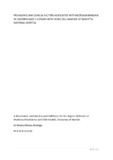| dc.contributor.author | Muthiga, Martin M | |
| dc.date.accessioned | 2014-07-14T08:53:03Z | |
| dc.date.available | 2014-07-14T08:53:03Z | |
| dc.date.issued | 2014 | |
| dc.identifier.citation | Master of Medicine (Paediatrics and Child Health) | en_US |
| dc.identifier.uri | http://hdl.handle.net/11295/72918 | |
| dc.description.abstract | Background: Sub-Saharan Africa has a high burden of sickle cell disease. Better care has led
to increased life expectancy, switching focus from early mortality to morbidity caused by
organ damage. One of the organs involved is the kidneys, with damage heralded by
subclinical changes such as microalbuminuria (MA) that can be diagnosed early allowing for
timely intervention. This can reduce progression to and incidence of end stage renal disease
(ESRD). The prevalence of microalbuminuria among children with SCD in our setting, and
need for routine screening is unknown.
Objectives: To determine prevalence and clinical factors associated with microalbuminuria
in children aged 2-18years with sickle cell anaemia at Kenyatta National Hospital (KNH)
Methods: This was a cross sectional descriptive study carried out at KNH. We recruited 110
eligible subjects whose records were reviewed to confirm sickle cell genotype then
interviewed to establish number of past admissions in the preceding year, hydroxyurea use
and history of severe vaso-occlussive phenomena. Physical examination was carried out and
anthropometric measures recorded. A spot clean catch urine sample and venous blood
samples were then collected and analysed for quantification of protein levels in urine,
serum creatinine and haemoglobin. Estimated glomerular filtration rate (eGFR) was
calculated for each subject and classified by K/DOQI guidelines2.
Results: The study population (n=110) comprised 62(56%) male and 58(44%) female subjects
with a mean age of 7.53(+3.7) years.
The mean haemoglobin concentration for the study population was 7.9(1.2) g/dl.
Over half the study group were on hydroxyurea at time of recruitment (61%) and only nine
subjects had history of severe vaso-occlussive phenomena. Fifty nine subjects (54%) had a
raised eGFR and only 2% had a low eGFR.
The prevalence of microalbuminuria (MA) was 39.1% with our youngest child with MA being
2 years old.
There was significant association with hyperfiltration (p=0.006, OR 3.06 95% CI 1.36 to 6.92)
but no significant association with age (p=0.805), gender (p=0.926), BMI (p=0.538), number
of hospitalisations (p=0.679) or haemoglobin concentration (p=0.58).
Conclusion: The prevalence of MA in our population is high and warrants regular screening
of all SCD patients. The onset was also noted to be at an early age thus screening should
start as soon as the diagnosis is made. eGFR should also be monitored as there was
significant association between MA and hyperfiltration. | en_US |
| dc.language.iso | en | en_US |
| dc.publisher | University of Nairobi | en_US |
| dc.title | Prevalence and clinical factors associated with microalbuminuria in children aged 2-18years with sickle cell anaemia at Kenyatta national hospital | en_US |
| dc.type | Thesis | en_US |
| dc.description.department | a
Department of Psychiatry, University of Nairobi, ; bDepartment of Mental Health, School of Medicine,
Moi University, Eldoret, Kenya | |
| dc.type.material | en_US | en_US |

